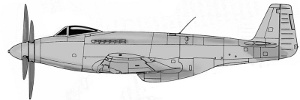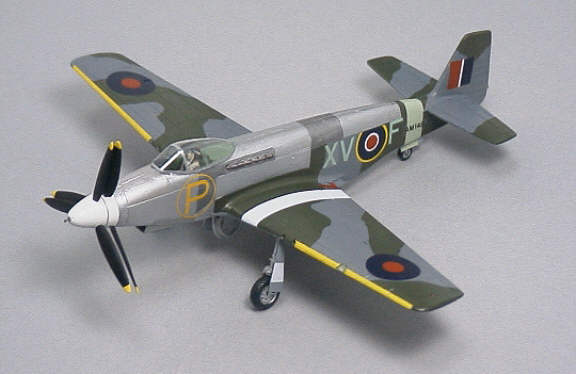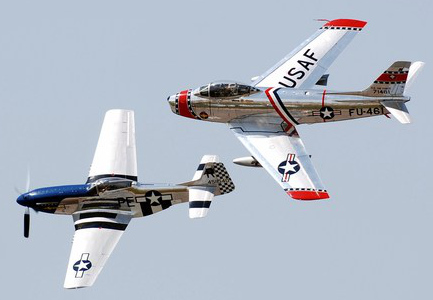P-51 Mustang
 |
 |
The greatest propeller fighter of all time -- the P-51 Mustang!
The P-51 was the most crucial weapon Americans had in Europe. Without the Mustang, air war over Nazi Germany would've been lost.
index
main page:
comparisons page:
trivia
- Simply "fifty-one" was what most WWII fighter pilots called a P-51 Mustang.
- Have seen a P-51D, Spitfire, Me-109 at a museum. Spitfire and Me-109 were same size, small. P-51D was larger than both, larger than expected.
- Its Rolls-Royce Merlin engine's torque was so powerful that hitting full-throttle right after take-off would flip airplane!
- In 1990, a ZR-1 Corvette tried to race a P-51 — P-51 literally flew past Corvette. Corvette never got the lead, either.
- P-51D's rudder and elevators were still fabric-covered like old bi-planes (P-51H was fully metal-covered).
- Flaps were large, could be dropped at high-speed to tighten turn.
- Wing was cranked, not for aerodynamics, but rather to accommodate landing gear (P-51B/D cranked more than P-51A). Crank was eliminated on light-weight models which had smaller landing gear.
- Both British and NACA engineers made major contributions to design of P-51. British defined its specifications, upgraded its engine, optimized its radiator scoop, invented bubble canopy, assisted in reducing its weight. NACA solved problems in its ailerons and stability, recommended installing a dorsal fin, replacing fabric with metal on its control surfaces.
- P-51B's handling and speed was marginally better than D.
- Each wing had a tiny aerodynamic fence near aileron.
- P-51 would accelerate instantly by diving, ~450MPH to >= 500MPH within seconds. UK test pilots noted, when diving, P-51s accelerated fastest, remained controllable, could maintain speed long after leveling. US test pilots warned if throttle was maxed and split-S (half-roll) was done, within seconds, speed would go past structural limits. Damage that occurred was serious but survivable (deformed leading edges, rivets and panels popping out, broken hydraulics).
- How fast could a P-51 dive? Test pilots flew to Mach ~0.85. Combat pilots very probably exceeded this speed. A test P-51D was dived several times, but every time Mach ~0.85 was reached, structural damage occurred, so test pilot couldn't try flying faster.
- NACA/NASA flew a P-51 chase-plane until 1970s or 1980s, stopped by lack of parts. [ref: nasa.gov: pix pix ]
-
~200 Mustangs survive.
Estimate bulk consists of ~90% P-51Ds and ~10% P-51A/Bs.
Others models are extremely rare or lost.
Six P-51Hs exist (two air-worthy).
One P-51G may exist(?).
One Twin Mustang is in USAF museum, another is becoming air-worthy [2018].
impact of P-51 in World War II
The P-51 was the most crucial weapon Americans had in Europe. Without the Mustang, air war over Germany would have been lost. No doubt, Soviets could have defeated Germans without help, but war would have lasted longer. Like atom bomb in Japan, P-51 shortened war in Europe. At one time, US was near to deciding to abandon strategy of bombing Germany, as German fighters were rapidly destroying bombers much faster than US could replace them. Soon after P-51 was deployed, air superiority was established. Despite TV documentaries claiming it was "hopelessly outclassed", propeller P-51D Mustangs managed to catch and annihilate Germany's Me-262 jets (P-51 vs Me-262).
Mustang variants
variants by North American Aviation:
- P-51A: razor-back, Allison V-12
- P-51B, P-51C Mustangs: razor-back, Rolls-Royce Merlin V-12
- P-51D, P-51K: bubble canopy
- P-51F, P-51G, P-51H: light-weight
- F-6: recon variant with side-mounted camera
- F-82 Twin Mustang
- F-82 Twin Mustang with turbo-props and cockpit moved forward
- winter variant with ski landing-gear
- Navy prototype with a tail-hook (radiator scoop made P-51 unsuitable as a navy plane)
- mid-mounted V-12 Griffon engine, contra-rotating props
- Mustang with ROCKET ENGINE
- Mustang with RAM-JETS
- Mustang with FORWARD-SWEPT WINGS and PISTON/JET engines
non-standard variants and replicas:
Please email if a variant is missing.
light-weight Mustangs
P-51F, P-51G, P-51H, P-51J

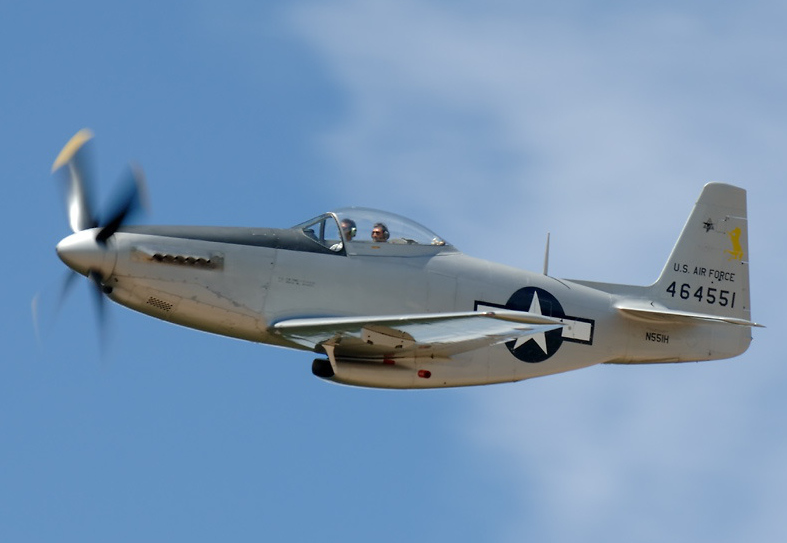

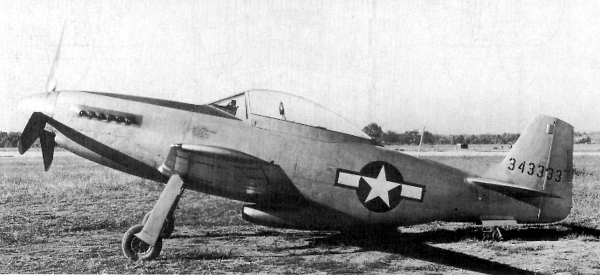 |
XP-51F weighed 1600lbs less than P-51D. 3-blade propeller. Top speed 466MPH. |
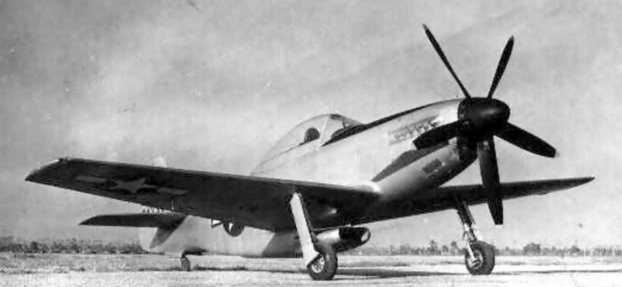 |
XP-51G had 2,200HP Rolls-Royce Merlin with 5-blade propeller. Top speed 495MPH. |
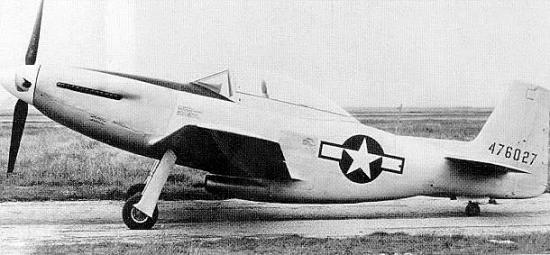 |
XP-51J had elongated canopy, Allison V-12 engine, carburetor scoop eliminated by integrating into radiator scoop, resulted in most streamlined Mustang ever. Top speed unknown because of engine problems. |
North American experimented with 4 light-weight prototypes: XP-51F/G/H/J. Ultimately, production light-weight Mustang was based on XP-51H.
P-51H
Improvements in P-51H:
- top speed ~490MPH
- rate of climb increased to 5,200 from 3,500 ft/min
- much lighter
- more maneuverable
- visibility improved, cockpit slightly moved up/forward, nose slanted downwards
- even more streamlined
- taller tail, longer/shorter dorsal fin
- wheels were smaller which eliminated crank in wings
- rear radiator scoop redesigned
- rear fuselage was deeper
- all-metal construction (earlier models had fabric/plywood for some control surfaces and trim-tabs)
Relative to P-51D, P-51H was shaped more angular. Test pilots comparing D and H noticed H's greater maneuverability, acceleration, climb-rate. In normal power settings, speed difference was marginal.
No P-51H Mustangs ever engaged in combat [ref: David McLaren], but NACA literature documents a few were (or were going to be) deployed to escort B-29s [ref: NACA, Reeder]. Prototype was being flight-tested in April 1945 when WWII Europe ended.
P-51H proved to be fragile. Tail-wheel was prone to collapsing, often ANG flew with tail-wheel locked down. Some had weak wing spars, ANG pilots were restricted to 2G.
When Korean War started, USAF choose to use P-51Ds and keep P-51Hs at home. In an odd reversal from its hand-me-downs policy, USAF actually gave newer/faster P-51Hs to ANG units in exchange for older/slower P-51Ds. Besides logistics, a reason was P-51D's reliability — P-51H gained speed by having a weaker frame, its wings were weaker, its tail-wheel was prone to collapsing. USAF may have wanted to keep the limited number of faster-but-fragile P-51Hs in reserve for homeland defense, since during early 1950s, the only fighter with long range was still the Mustang.
Only 6 P-51H models survive [ref: p51h.home.comcast.net]. At least 2 are airworthy.
P-51I designation was skipped (?). P-51K was just a P-51D with a different propeller.
[ref: North American P-51H Mustang by David McLaren]
[ref: NACA, Reeder]
[ref: p51h.home.comcast.net]
F-82 Twin Mustang
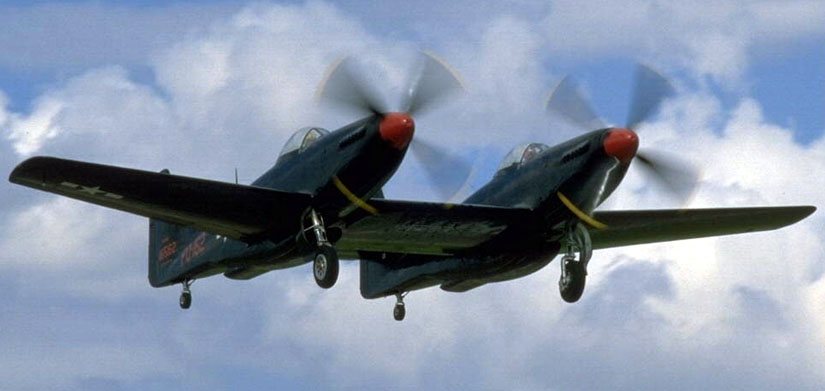
- F-82 flight characteristics:
-
Although Twin Mustang was a strange-looking airplane, its flight characteristics were normal. Compared to P-51D, F-82 had better climb, heavier wing-loading.
Rolling felt normal and natural, neither co-pilot would become unusually dizzy. When Twin rolled (like any airplane), rolling motion is a cork-screw, with pivot being a point above airplane.
Rolling quickly back-and-forth was a prohibited maneuver since its tails would wobble. Its other prohibited maneuver was snap-roll.
A Twin Mustang doesn't look like it has a fast roll rate. However, a pilot said it would roll fast and was "aerobatic", mentioning ailerons were full width of wings.
Top speed of F-82B (Merlin) was 480MPH.
Climb rate of F-82B (Merlin) was 4,900ft/min.[ref: Twin Mustang by Alan Carey]
- Twin Mustang shot down a Yak-9 fighter in Korea:
-
Yak-9 was a very good propeller fighter, near to a Spitfire in performance. Yak-9 had a rearward radiator like a P-51. Although not truly swept-back, its wings were angled at front and back.
- F-82 Twin Mustang vs P-38 Lightning (Edgar Schmued vs Kelly Johnson)
- turbo-prop Twin Mustang:
-
North American proposed to build a Twin Mustang powered by turbo-props. Cockpits were moved far forward. Drawings were made. Never built.
mid-engine Mustang
British engineers at Rolls-Royce built a Mustang prototype with a powerful Griffon V-12 engine mounted in middle with contra-rotating propellers, named "Mustang FTB" (Flying Test Bed). Potentially could have been the fastest, best handling, most maneuverable Mustang of all. Development stopped, never reached test-flight stage, because British decided to focus on jet fighters.
[ref: "Rolls-Royce and the Mustang" by David Birch]
Mustang with a ROCKET engine
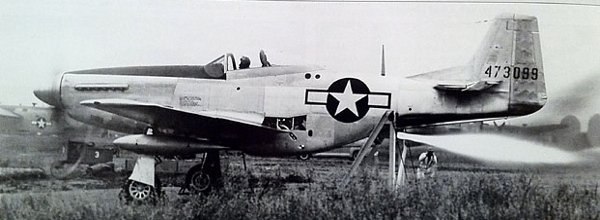

During WW2, North American Aviation fitted a rocket engine to a P-51D near radiator exhaust. Speed was boosted to 513MPH for ~1 minute. 1000lbs rocket-fuel tank added drag and unbalanced plane. Test-pilot was almost killed after rocket-fuel fumes entered cockpit. North American and USAAF concluded this type of rocket-engine was too dangerous and not practical.
[ref: Mustang Designer by Ray Wagner, "Mustang" magazine]
Mustangs with RAM-JET engines
 pix may look fake but it was real!
pix may look fake but it was real!
 P-51D with German-influenced under-wing ram-jets
P-51D with German-influenced under-wing ram-jets
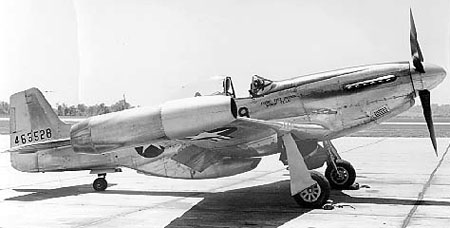 P-51D with Marquardt wing-tip ram-jets
P-51D with Marquardt wing-tip ram-jets
Amazingly, two P-51 Mustangs and one F-82 Twin Mustang were fitted with jet engines of different types.
First P-51 had pulse jets, based on a German design, under wings. Info about speed boost and when it was made isn't available.
Second P-51 had US Marquardt ram jets on wing-tips. Speed was boosted by 50MPH and was made after WW2 in 1946.
[video: P-80 with ram-jets]
[ref: Marquardt (wikipedia)]
Mustangs with SWEPT WINGS
 North American designed a Mustang with forward-swept wings and piston/jet engines.
North American designed a Mustang with forward-swept wings and piston/jet engines.
 Swept-wing F-86 Sabre was an evolution of Mustang.
North American started F-86 in 1945, a (non-flyable) straight-wing F-86 prototype was made before WWII ended
[photo in Ray Wagner's book].
Even earlier, Sabre's sibling, FJ-1 Fury, designed in 1944,
was a Mustang evolved with a jet engine.
Swept-wing F-86 Sabre was an evolution of Mustang.
North American started F-86 in 1945, a (non-flyable) straight-wing F-86 prototype was made before WWII ended
[photo in Ray Wagner's book].
Even earlier, Sabre's sibling, FJ-1 Fury, designed in 1944,
was a Mustang evolved with a jet engine.
"Miss Ashley" was a replica racer with swept-back wings (from a Lear-jet IIRC).
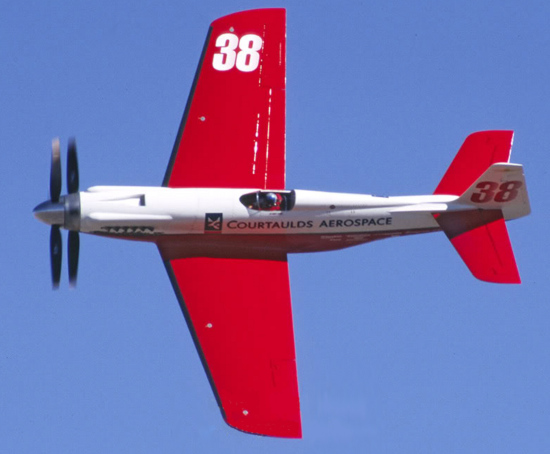
[ref: Mustang Designer by Ray Wagner]
Mustang with FORWARD-SWEPT WINGS and PISTON/JET engines
 pictures of forward-swept P-51 with piston/jet engines
pictures of forward-swept P-51 with piston/jet engines
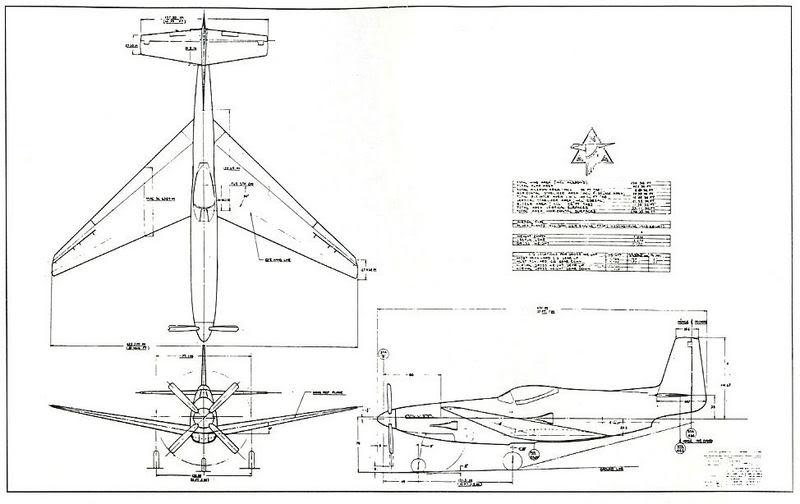
North American designed a P-51 with forward-swept wings and piston/jet engines. Only a wind-tunnel model was built. Initial sweep angle was too great (wings would've bent off at high speed and AoA), was reduced to 15 degrees. Dihedral angle was great (to compensate for forward sweep, AFAIK).
Boeing's "Sweeping Changes" (PDF): "In the quest for increased maneuverability, the top post World War II U.S. fighter, the P-51 Mustang, was selected for the new wing. Boeing predecessor company North American Aviation designed an FSW P-51 concept. However, during wind tunnel tests the rigid aluminum wings twisted asymmetrically, indicating potential loss of control. Further testing determined the wings had to be limited to 15-degrees forward sweep. Increased speed and high g-force turns would lead to structural divergence, or wing separation. The FSW P-51 was never built."
[ref: North American P-51 Mustang by Frederick Johnsen]
[ref: Boeing's "Sweeping Changes" (PDF)]
Nazi Mustangs
Germany captured a few downed P-51s, repaired them somehow, flew them painted with German markings. That is considered fair-use according to flag rule of war, each side did that. However, interviewed US fighter pilot said he viewed that as a deadly infiltration trick and reacted with vengeance.

Cavalier/Piper Mustangs

Cavalier began refurbishing war-surplus Mustangs. When Merlin V-12 engine parts became scarce, Cavalier made conversions to turbo-props, named "Cavalier Turbo Mustang". But these conversions apparently were hacks, judging from misshapen nose and fuselage.
In 1984, USAF evaluated and rejected Piper Enforcer for close-air-support. Piper streamlined nose and fuselage, but turbo-prop exhaust was asymmetric which may have caused yaw instability. Despite having a turbo-prop engine, Enforcer was slow, ~350MPH. Fundamental problem was P-51's shape was designed solely for speed, sacrificing visibility required for close-air-support. Purpose-built A-1 Skyraider and A-10 Wart Hog with forward cockpits are better suited.
clones/imitations
Mustang's design had influences on several other aircraft.

|
British Martin-Baker MB5, which had great potential, resembled a Mustang. |

|
Australia tried to develop their CAC CA-15 Kangaroo fighter which had strong resemblance. |

|
Supermarine Spiteful, although a derivative of Spitfire, evolved in direction of Mustang, with square laminar-flow wings and greater streamlining. |
the Mustang -- evolved into a jet fighter

P-51  F-86
F-86  F-16
F-16
 North American's FJ-1 straight-wing and FJ-2 swept-wing Fury jets
North American's FJ-1 straight-wing and FJ-2 swept-wing Fury jets
 FJ-1 Fury jet shows its evolution from Mustang
FJ-1 Fury jet shows its evolution from Mustang
North American developed straight-winged FJ-1 Fury which was essentially P-51 with jet engine. Fury quickly developed into F-86 Sabre which still resembled Mustang. Even today, many vestiges of P-51 and F-86 still exist in F-16 Viper -- bubble canopy, jet's duct, and cranked vertical stabilizer.
F-16 designers copied the top/front shape of P-51 radiator scoop. Top of scoop has a characteristic V-shape.
books
-
"Mustang Designer: Edgar Schmued and the P-51" by Ray Wagner.

Like its title says, it's about Schmued and also design of P-51. Has info about rocket-engined P-51s.
-
"Mustang: The Story of the P-51 Fighter" by Robert Gruenhagen.
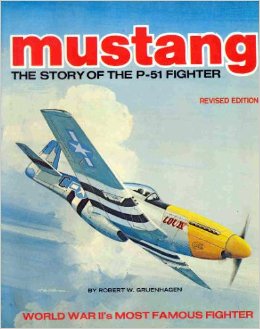
Perhaps the finest book about P-51.
-
"Pilot Training Manual for the P-51 Mustang" (aka "North American P-51 Mustang Pilot Training Manual").
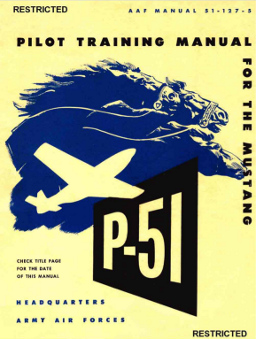
A delightful book written for novice fighter pilots.
-
"North American P-51H Mustang (Air Force Legends 209)" by David McLaren.
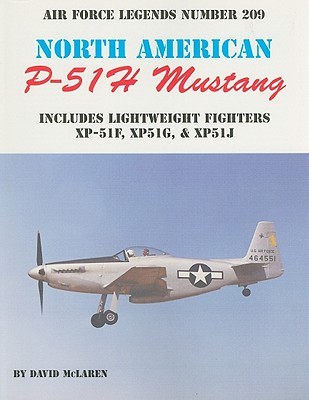
Details of the four light-weight Mustang versions (XP-51F/G/H/J) with lots of pictures.
-
"Building the P-51 Mustang" by Michael O'Leary.
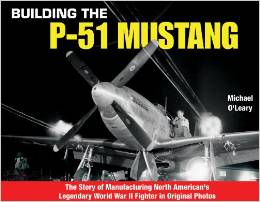
Very detailed.
-
"North American P-51 Mustang (Warbird Tech)" by Frederick Johnsen.

Contains info and drawing of forward-swept wing P-51.
-
"Twin Mustang" by Alan Carey.

-
"Flying to the Limit: Testing WWII Single-Engined Aircraft" by Peter Caygill.
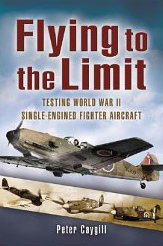
Documents abilities and limitations of P-51 and other aircraft, written from a British test pilot's POV.
-
"Hitler's Jet Plane: The Me-262 Story" by Mano Ziegler.

Excellent translation, written in a narrative style (this complements Robert Dorr's book very well). Documents top speed of Me-262 as reported by a defector, and disillusionment of German pilots after finding Me-262 was dangerously unreliable and their jets were nowhere near invulnerable to escorting P-51s.
-
"Fighting Hitler's Jets" by Robert Dorr.
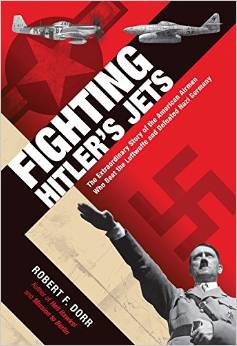
Excellent book write in a narrative style but short of technical details. Documents about 100 cases of Me-262s shot down by P-51 (and even P-47) fighters (omits kills by British Spitfires and Tempests being a book from US POV).
movies, TV, videos
-
History Channel's "Dogfights"
History Channel's "Dogfights" is excellent. One episode was devoted to P-51 and a few other episodes have segments with P-51. Note that occasional minor inaccuracies appear in "Dogfights".
-
"Red Tails"
CGI dog-fights are awesome. Just press FWD to dog-fights (rest of movie is trash).
-
Mustangs have appeared in many movies and TV shows. Steven Spielberg admires P-51, he filmed them in "Saving Private Ryan" and "Empire of the Sun". Chris Carter also, he featured one in "Piper Maru" X-Files episode. "Air Power" by Walter Cronkite.
-
Awesome video of Kermit Weeks of Fantasy of Flight flying a P-51C razor-back. Take-off is scary fast!!

- video: "Flight Characteristics of the P-51 Airplane" (1944).
- video: F-82 Twin Mustang
- video: "Eighth Air Force Fighter Combat vs ME-163 Rocket-Propelled and ME-162 Jet-Propelled Aircraft"
- video: P-80 with ram-jets
-
"P-51 Dragon Fighter"
P-51 Mustangs had to battle:
- Nazi JET and ROCKET fighters.
- Nazi FLYING SAUCERS.
- Nazi DRAGONS.
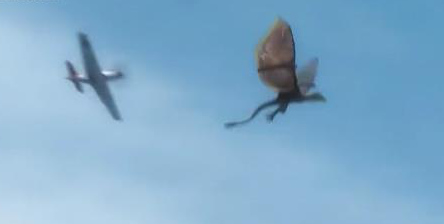
-
Declassified top-secret film showing a P-51 chasing and dog-fighting a UFO over France.
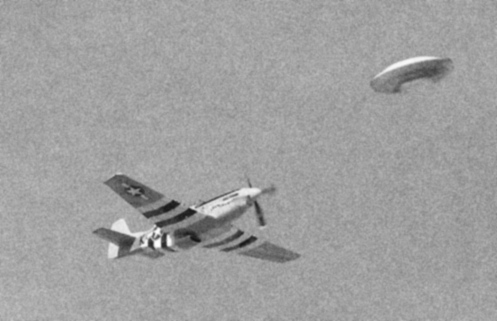
links
Joe Baugher
aerofiles.com
airvectors
Bud Anderson
mustangmustangs.com
Warbird Registry
restoration of a F-82 Twin Mustang
https://www.crazyhorseap.be
http://p51h.home.comcast.net restoration of a P-51H Mustang
http://xp51g.com restoration of the unique P-51G prototype
next page
... P-51 Mustang compared to other airplanes ...
 Yak-9
Yak-9
